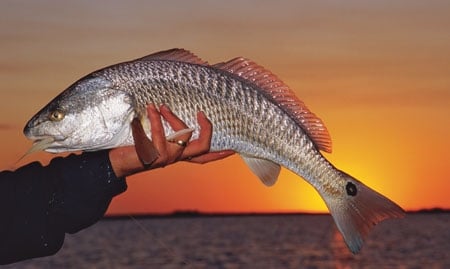
SIMPLY RED: It sounds fundamental, but to catch reds consistently, fish where you’ve caught them in the past.
Photo: Scott Sommerlatte
Love them or hate them, fishing tournaments advance the angling learning curve at a blistering pace. When there are thousands of dollars on the line and your task is to find and catch fish in a hurry, patience is not a virtue and innovation helps you go home with the prize.
In the world of redfish tournaments, Captains Rick Murphy and Scott Guthrie haven’t merely stayed ahead of the learning curve, they’ve owned it and have the resum¿ to prove it. In February, the pair added to their record as the winningest team in competitive redfish angling by capturing their second consecutive FLW Redfish Championship and remain the only team to have won tournaments on the Inshore Fishing Association Tour, the FLW Redfish Tournament Circuit and the ESPN Redfish Cup. In short, they know how to catch fish-fast-and say they owe it all to their ability to find what they call the right “redfish Zip Code.” Recently, SWS caught up to Murphy to grill him about the team’s redfish tactics.
“There are about 400 competitive, two-man teams fishing all the redfish circuits throughout the nation,” Murphy says. “They’re all good fishermen, but Scott and I feel our strength is in finding areas where the water is shallow, and we’re able to see the fish we want to try to catch before we ever cast to them.
“We like to sight-fish for reds because then we have much more control over which redfish bite our lures than when we’re fishing in deep water,” Murphy continued. “And that’s important in tournament angling when we have to observe slot limits. We’re not just hoping to catch redfish, but actually the biggest redfish within the slot limit of the particular state we’re fishing. By using this technique, we don’t waste our time casting to a four-pound redfish if we already have two five-pounders in the live well.”
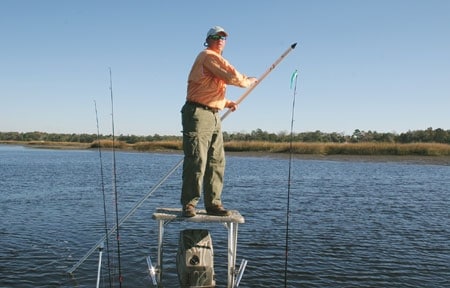
POLE POSITION: Sight-casting provides pro anglers with the opportunity to size up slot-limit fish before they bite.
Photo: Bob McNally
Reds in a Zippy
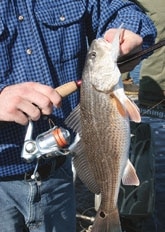
| |Photo: Bob McNally| At the core of Murphy and Gutherie’s successful tactics is their approach. Murphy will either pole or use his trolling motor to move his boat down the shoreline until he locates fish. He push-poles the boat in water less than 12 inches deep, but carefully uses his trolling motor when searching in deeper water.
“I run my trolling motor at one-third of its maximum speed to keep the motor constantly running at the same pitch and the same tone so as not to spook the redfish,” Murphy says. “I’ve seen tournament fishermen turn their trolling motors up wide open, run it for 20 yards, turn it down or off and use that on-off, fast-slow tactic all the way through the area they want to target and scare off fish.” With this stealthy approach, Murphy believes he can find an area to sight fish anywhere in the country.
“In tournament fishing, you have to go with what you know,” Murphy says. “If you’ve fished an area in a tournament in a particular region, then you can return to that tournament’s site the following year and look for redfish in the same places. Generally, the reds will be in the Zip Code.”
Once in the right zone, final approach and boat position that affords both anglers shots at reds are key.
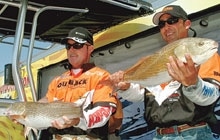
| |RED KINGS: Rick Murphy (left) and partner Scott Guthrie are two-time FLW redfish tourney champs. Photo: John E. Phillips| “I’ll stand on the tower with a push-pole in my hand and my fishing rod between my legs,” Murphy says. “When I see a fish I want to cast to, I’ll put the push pole between my legs, pick up my rod and cast to the redfish, and then we have two fishermen actually fishing instead of one poling.”
Because lure presentation is so critical for catching redfish, Murphy says the boat has to be in position so you can make the lure move to the side or away from an oncoming red.
“If you cast in front of the redfish and move the lure toward the fish, you’ll spook it,” Murphy says. “As a predator, the redfish knows that prey usually flees. Therefore, when we’re sight fishing with plastic baits, having the boat in the right position is critical.”
Three Baits and How to Fish Them
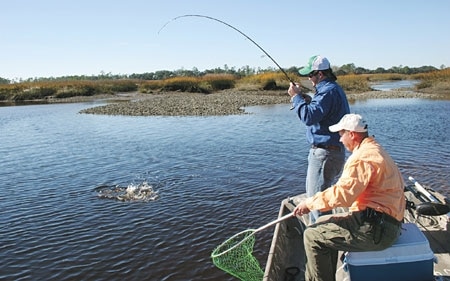
PICK A BAIT: Situational lure selection means more hookups.
Lure selection for the team boils down to three types of lures for three different types of fishing conditions.
Topwater: “To catch the redfish feeding on the surface, we use the Rapala Skitter Walk, which is a walk-the-dog type of surface lure,” Murphy says. “It has rattles inside that click as you twitch it, which is why we call this type of fishing, ¿¿Clickity-clack, going down the railroad track.’ This lure is the only one we use when we’re fishing shallow water for redfish feeding on the surface.”
The Skitter Walk comes in two sizes, eight- and ten-inch. Murphy prefers the baby redfish color, which features a white belly and a redfish-scale pattern on the side and even has a dot on the tail-end of the lure. The pair also use a mullet-colored model.
Mid-water: If ever innovation were necessary, tournament redfish angling is the time. The daunting chore is to catch fish under any circumstances, and that means occasionally relying upon mid-water baits when conditions dictate.
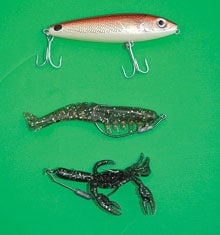
| |The Skitter Walk, Exude Shrimp and Crabs are favorites.| “When we’re fishing a spinnerbait, we usually have an interchangeable jighead so we can swap the color or the weight that we use,” says Murphy. “Instead of a traditional bass skirt, we’ll use a paddle-type of plastic grub or worm as a trailer for the spinnerbait. We prefer the H&H; spinnerbait frame with its plastic trailer, and then we use a Strike King jighead in either the 1/4- or 1/8-ounce size.”
Most often, Murphy and Guthrie will go to a dark-colored trailer when fishing a spinnerbait to cover a vast amount of water quickly.
When spoons get the call, and they often do, it’s either the Johnson Silver Minnow or the Terminator spoon for mid-water fishing.
Shallow Water: When the pair fish in shallow water, 12 inches or less, they prefer the Exude Shrimp or Exude Crab made by Mister Twister.
“We use the Exude Shrimp in two ways,” Murphy says. “We’ll put a 5/0 weedless Mustad hook on it and rig it weedless-like bass fishing.”
To coax the fish into biting, Murphy casts about 1 1/2 feet past the redfish. Then when the fish gets close, he’ll twitch his rod tip to get the attention of the redfish.
Landing Patterns
Despite the frenetic lip-ripping images conjured up by tournament fishermen, Murphy and Guthrie prefer a more systematic approach to landing redfish, relying on gear and guile to pour reds into the live well.
Guthrie typically loads his reels with ten-pound-test PowerPro with a 36- to 46-inch-long, 20- to 25-pound-test fluorocarbon leader, especially in clear water. Murphy prefers SpiderWire Fusion.
“I still believe when the water’s clear, shallow and calm, you can downsize your line and use monofilament,” Murphy says. “I like eight-pound-test Rapala Finesse Monofilament under those conditions.”
By using eight-pound-test line, Murphy can extend his casts and is convinced that the reds can’t see small-diameter monofilament as well as braided line or heavier mono.
Murphy’s rods and reels include a Pflueger Presidential baitcasting reel combined with a six- or a 6 1/2-foot baitcasting rod with a medium to heavy action. For spinning, he prefers a seven-foot medium- to heavy-action rod. When he’s making a long cast with topwater lures and spinnerbaits, Murphy uses his baitcasting rod. However, when he’s sight-fishing with either the Exude Crab or the Exude Shrimp with no weight, he switches to spinning gear.
“I don’t try to winch a fish into the boat,” Murphy says. “We put about three pounds of drag on our reels and when the redfish starts thrashing on the surface, we’ll yield the rod to the fish because all we want to do at that point is stay connected.”
When the redfish pulls hard, Murphy gives it line and then takes up line when the fish relaxes. Murphy and Guthrie have found that they land more reds by using less drag and more angling skill rather than brute force and heavy rod pressure. The pair also swears by a dip net.
“We use a StowMaster net that has three extensions in the handle that allow us to reach out 8 1/2 feet,” Murphy says. “The net also prevents the fish from escaping if it tries to bulldog down to the bottom. The angler who has the fish on the line attempts to keep the redfish’s head high in the water until the other angler gets the net under it. If you try and put the net under a redfish when its head is down, the fish will often dodge it and break off or else they’ll hit the net and get away.”
Unfortunately for the other teams in the world of redfish tournament fishing, that doesn’t happen to Murphy and Guthrie very often.









